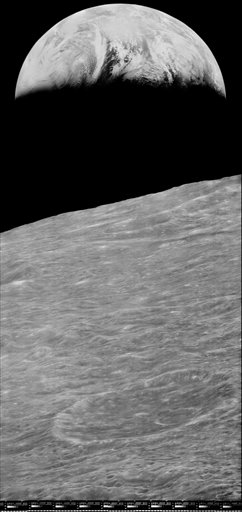Restoring the Moon: Lunar Orbiter Images Recovered

Forty three years ago, Charles J. Byrne, a Bellcomm, Inc.engineer, became concerned about NASA's plans to archive the data to be sentfrom a series of Moon mapping precursor missions to the Apollo lunar landings.
The Lunar Orbiter telemetry, which just two years and five unmanned missionslater would account for imagery of 99 percent of the Moon, was originallyplanned by the space agency to be recorded on photographic film only. The fiveorbiters themselves would carry the equipment to develop their film and thenscan it for transmission back to Earth. Once there, it would then be reprintedin strip form to then be manually re-assembled and re-photographed for study.
Anyone who has used a copy machine to make a copy of a copy knows thatresolution is lost in the process. The same was true for Lunar Orbiter, thoughfor NASA, which needed quicker access to the data than computers of that daywere able to provide, the resulting images would be what they needed toevaluate landing locations for Apollo.
Still, thought Byrne, there would be valueto having a tape back-up, so he outlined his idea for a Lunar Orbiter DVR-like system in a July 1965 memo.
"It is concluded that the ability to fully optimize the later site surveymissions on the basis of early Lunar Orbiter data depends on an immediatedecision to provide tape recorders," wrote Byrne.
NASA agreed and AMPEX FR-900 2-inch analog tape recorders were positioned atthe Goldstone, California, Madrid, Spain and Castle Island (Woomera), Australia tracking stations to record all the images from the Lunar Orbiter spacecraft.
Byrne had referenced "later site survey missions" in his memo. Whathe didn't know -- what he couldn't know then -- was how much later those tapeswould come back into use.
Breaking space news, the latest updates on rocket launches, skywatching events and more!
Earthrise and the sun sets on Lunar Orbiter
Though Lunar Orbiter was quickly overshadowed by the manned Apollo missions,they did accomplish a number of firsts. The spacecraft captured the first highresolution global map of the Moon, the first stereo imagery of the surface, andthe first images of the Earth from the Moon.
The latter was particularly noteworthy as it amounted to the spacecraft'scontrollers turning Lunar Orbiter 1 away from the surface to take what wasessentially an artistic shot. The black and white image was quick to capturethe public's attention.
"And the other one of course, is earthrise, Earth rising above the surfaceof the Moon," continued Cowing in an interview with collectSPACE.com."At the time, all the photos were either television or photographs thathad been sent back and they were murky."
"Veryshortly thereafter, we landed on the Moon and there were the ghostly images ofpeople walking on the Moon."
That astronauts landed safely and explored the surface meant that the LunarOrbiters had done their job. With the Apollo program coming to a close andwithout a pressing need for the Lunar Orbiter data, NASA put the tapes intostorage, first in Maryland and then in the mid-1980s they were moved to the JetPropulsion Laboratory in California.
That's where they came under the care of Nancy Evans, co-founder of the NASAPlanetary Data System (PDS).
Evans, working with Mark Nelson of Caltech, began a project to obtain surplusFR-900 tape drives, refurbish them, and digitize the Lunar Orbiter analog dataon the tapes. They were successful in so much that they were able to obtain thetape drives and get them running, but without funding the project folded.
By the early 1990s, Evans had retired from JPL, taking with her thegovernment-surplused drives in the hope of finding private funding to continuethe project she began...
Continue readingabout NASA's Lunar Orbiter Image Recovery Project and view the newly released imagesof the Moon at collectSPACE.com.
? 1999-2008collectSPACE.com All rights reserved.

Robert Pearlman is a space historian, journalist and the founder and editor of collectSPACE.com, a daily news publication and community devoted to space history with a particular focus on how and where space exploration intersects with pop culture. Pearlman is also a contributing writer for Space.com and co-author of "Space Stations: The Art, Science, and Reality of Working in Space” published by Smithsonian Books in 2018.
In 2009, he was inducted into the U.S. Space Camp Hall of Fame in Huntsville, Alabama. In 2021, he was honored by the American Astronautical Society with the Ordway Award for Sustained Excellence in Spaceflight History. In 2023, the National Space Club Florida Committee recognized Pearlman with the Kolcum News and Communications Award for excellence in telling the space story along the Space Coast and throughout the world.
